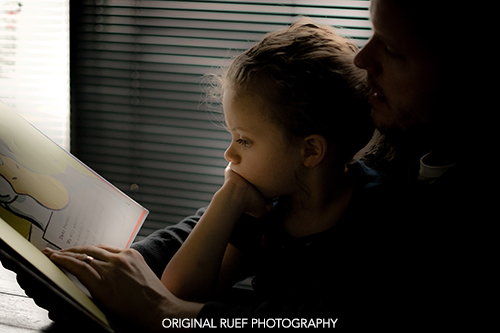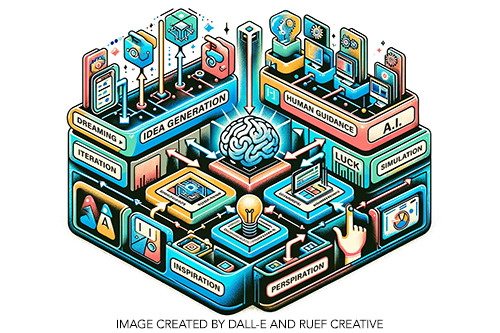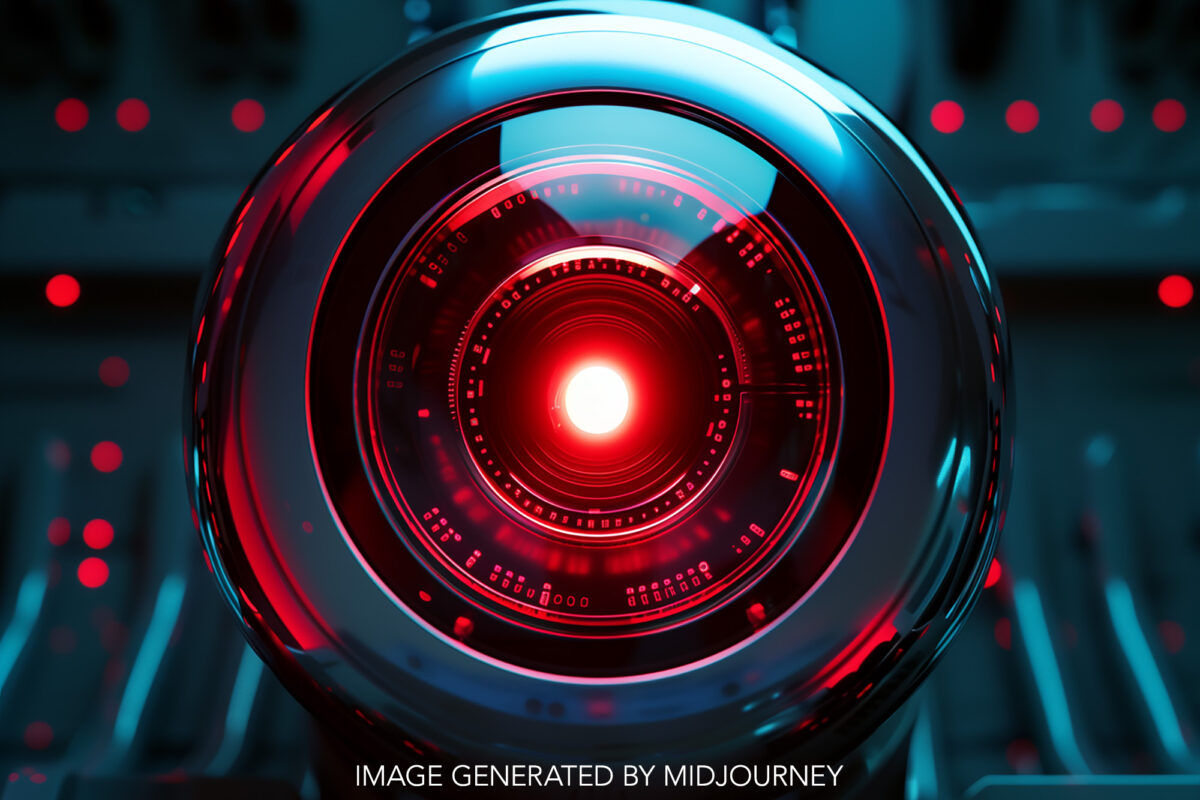The Artificial Intelligence (AI) revolution is upon us. No longer the stuff of conjecture and future promises, AI is offering accessibility, efficiency, and productivity, today. From AI-generated photography and logo design to automated marketing writing, this evolving technology is already in wide use all around us. Yet, as many businesses have discovered, the magic of AI often falls short when it comes to the nuanced art of creative design and authentic engagement. The truth is, current AI technologies themselves are tools of creative people, not replacements for creative people. At ruef, we embrace the integration of AI technology with traditional human design, crafting creative output that still resonates on a deeply human level.
What is AI, really?
In creative design and writing, we’re referring to sophisticated AI technologies like ChatGPT, Midjourney, Gemini, and Grammarly, just to name a few. These tools, developed by companies like Google, Microsoft, and OpenAI, use advanced neural networks and deep learning algorithms to perform specific tasks like generating human-like text, creating imaginative visuals from textual descriptions, and enhancing writing quality. For example, ChatGPT, launched in November 2022, excels in content creation and natural conversation, while Midjourney focuses on artistic image generation, and Gemini, unveiled in 2023, offers contextually aware natural language processing. Bing Chat integrates AI to enrich search experiences, and Grammarly has evolved to provide comprehensive writing assistance.
Science fiction often portrays AI as possessing logical intelligence and self-awareness, akin to human cognition. These fictional AIs, like HAL 9000 from “2001: A Space Odyssey” or the androids in “Westworld,” are depicted as fully autonomous entities with consciousness, emotions, and the ability to reason independently. They can understand complex human emotions, create original ideas, and make decisions based on a deep understanding of their environment. This level of AI involves self-awareness and general intelligence, where the AI can learn and apply knowledge across various domains independently. Such AI remains a theoretical concept and a topic of ongoing research and ethical debate, far removed from the task-specific and non-sentient AI technologies we use today.
Current real-world AIs, despite their sophistication, fundamentally differ from these fictional technologies. Today’s AIs are built on machine learning algorithms that process vast amounts of data to recognize patterns and generate outputs. They excel in specific tasks such as natural language processing, image generation, and writing assistance. However, they lack genuine understanding or awareness; they operate based on statistical correlations rather than comprehension. They excel in their designated tasks but lack the autonomous cognition and emotional depth of their fictional counterparts, remaining task-specific and non-sentient. There is no debate that they are powerful tools, but they are far from a replacement for human intelligence.
The Allure and Limitations of AI in Creative Work
In the short time since the first publicly accessible AI tools burst onto the scene, the technology has already made remarkable strides in areas like photography, graphic design, and copywriting. AI-generated photography, for instance, can produce stunning, high-resolution images in mere seconds. Logo design algorithms can churn out a myriad of options based on a few simple inputs. Automated writing tools can draft blog posts, social media updates, and even product descriptions with impressive speed.
The promise of simplified, cheap, and effective content creation and graphic design is, of course, an attractive prospect. However, businesses often find that the initial thrill of AI’s capabilities soon gives way to a sense frustration. AI-generated content tends to be repetitive, predictable, and homogenized. It lacks the authenticity, originality, and emotional depth of human created content. And as AI usage becomes more widespread, its output becomes increasingly generic. There is a sense of being caught in a feedback loop, trapped in an ocean of sameness that fails to capture the unique essence of any brand.
The Human Touch: Why Authenticity Matters
Humans crave connection and authenticity. We are drawn to stories that reflect real experiences, emotions, and imperfections. This is where AI falters. The flaws and nuances of real people make marketing content approachable and pleasant to engage with. Authenticity is recognized and valued by audiences, creating a sense of trust and loyalty.
For example, consider custom photography versus stock imagery. While stock photos are readily available and cost-effective, they often feature generic models in artificial environments. AI generated photography is another level removed from authenticity and is often trained with libraries of stock photography. Custom photography, on the other hand, showcases the real people and places behind a brand, delivering a genuine message that resonates more deeply with audiences. Of course, stock and AI generated photography has its place in marketing and design, but its use and value is not the same as custom photography. At ruef, our team of photographers and designers create custom imagery that is not only relevant and unique but also a reflective of the spirit and character of the business it represents.
There is science that supports the idea that the human brain has an inherent aversion to exposure to the artificial. In interior design, it’s been proven that we react negatively to repetitive, predictable, artificial patterns mimicking natural ones, drawing a compelling parallel to the reception of AI-generated content across various mediums. We are attuned to the subtle cues that AI often misses and, in essence, our brains don’t like being tricked.
This isn’t the first time creatives have dealt with this phenomenon. The concept of the “uncanny valley,” a challenge for CGI animators years ago, perfectly illustrates how human brains react negatively to artificial imitations. The uncanny valley is a term coined by roboticist Masahiro Mori in 1970 to describe the eerie or unsettling feeling people experience when a robot or animated character appears almost, but not quite, human. As the appearance of an artificial human becomes more human-like, our emotional response becomes increasingly positive – until a point where the resemblance is very close but not quite perfect. At this point, the emotional response drops sharply into the “uncanny valley,” where the almost-human figure feels strange and discomforting.
AI generated photos, graphics, and writing can fall into similar traps. AI currently lacks the ability to perfectly mimic the countless subtleties of real images. Overly perfect patterns can trigger a sense of artificiality. And while AI can produce text that appears sophisticated and well-structured, it often lacks the emotional depth, unpredictability, and unique voice found in human writing and can feel oddly mechanical or soulless.
Whether in visuals or writing, the fine line between convincing realism and unsettling artificiality highlights the importance of maintaining authenticity and human touch in creative works. By acknowledging and addressing these nuances, we can better leverage AI’s capabilities without falling into the traps of the uncanny valley.
AI and Human Creativity: A Powerful Partnership
Over-reliance on AI leads to lifeless marketing content devoid of creativity and connection. As more businesses turn to AI for quick and cheap solutions, the uniqueness of individual brands can get lost in the mix. The result is a flood of marketing content that looks and sounds eerily similar, lacking the distinctiveness that makes a brand memorable.
 Rather than viewing AI as a replacement for human creativity, we see it as a powerful partner. AI can handle repetitive tasks, analyze vast amounts of data, and offer insights that guide creative decisions. This frees up human designers and marketers to focus on what they do best: crafting compelling narratives, designing visually stunning graphics, and creating emotionally engaging content.
Rather than viewing AI as a replacement for human creativity, we see it as a powerful partner. AI can handle repetitive tasks, analyze vast amounts of data, and offer insights that guide creative decisions. This frees up human designers and marketers to focus on what they do best: crafting compelling narratives, designing visually stunning graphics, and creating emotionally engaging content.
It’s not uncommon for a client to approach us about logo design after trying freely available AI solutions, including options specifically built for logo generation. They quickly realize that those designs, at best, may be serviceable in the short term, but they’re not the kind of work on which to build a brand. Our approach begins with understanding a company’s brand identity, mission, and audience. We may use AI to generate a range of initial concepts based on our input criteria, drawing from current design elements and trends. These concepts can then be refined and enhanced by human designers who bring their unique perspective, creativity, and understanding of the brand to the process. This combination ensures that the final design is both efficient and deeply reflective of the brand’s identity. There is nothing like reaching the point where a thrilled client has found a logo that “feels right.” AI may speed up the process, but only human creatives can get us to that “aha” moment.
Automated tools can also generate blog posts, social media updates, and even video scripts. These tools are excellent for producing large volumes of content quickly. However, automated content often lacks the personal touch and nuanced understanding that human writers bring. We use AI to streamline the content creation process, generating initial drafts, ideas, or outlines. Our human writers then take over and do the heavy lifting, expanding on concepts and refining and personalizing the content to ensure it aligns with the brand’s voice and resonates with the target audience. This approach allows us to produce high-quality content efficiently while maintaining the authenticity and engagement that only human creativity can provide.
The Future of AI and Human Collaboration in Marketing
Looking ahead, the integration of AI and human creativity will continue to evolve. As AI technology becomes more sophisticated, its ability to manage complex tasks will improve. However, the need for human creativity, intuition, and emotional intelligence will not only remain, it may become more vital to the process.
It will be impossible to avoid the integration of artificial intelligence and the work of creative people. Already, almost every piece of major design software has started building in AI functionality. By leveraging the strengths of both AI and human creativity, we can create better work, faster and more cost effectively.
If you think about it, though, the work of man and machine has always been marching down this path. Design software has long integrated human creativity with artificial intelligence, transforming creative processes across various fields. From early computer-aided design (CAD) tools that enhanced precision and efficiency in technical drawings to advanced graphic design and photo editing software like Adobe Illustrator and Photoshop, AI has automated repetitive tasks and provided powerful editing capabilities. Even the first lowly spell-checking features of early word processors are an example of artificial intelligence as a tool for human creativity. This synergy allows humans to focus on intuitive, emotional, and culturally relevant aspects of design, while AI offers data-driven insights, speed, and precision, leading to more innovative and impactful creative work.
At ruef, we are committed to staying at the forefront of this evolution. We continuously explore new AI technologies and integrate them into our creative processes, ensuring that we deliver innovative solutions for our clients. Our ultimate goal is to harness the power of AI while preserving the human touch that makes our work truly exceptional.
The Power of Balance
The integration of AI technology and human design is not about choosing one over the other. It’s about finding the right balance. AI can handle the heavy lifting, analyzing data, generating initial concepts, and automating repetitive tasks. Human designers and marketers bring creativity, intuition, and emotional depth, transforming AI-generated insights into compelling narratives and stunning visuals.
For businesses looking to elevate their marketing efforts, this balanced approach is key. By embracing both AI and human creativity, they can achieve efficiency, innovation, and authenticity. At ruef, we are experts in blending these elements to create work that stands out among the competition, be it human or AI.
Ready to transform your marketing strategy with a blend of innovative technology and human creativity? Contact ruef Creative today and let’s create something original. Together.

